Due to personal reasons, I am incapable of talking about pain without humor. It’s a defense mechanism, I admit—when you’re dealing with it a lot (chronic pain is a thing I’ve been accustomed to for the majority of my life), sometimes it’s easier to make light of it. But the other day I realized something about how I apply this lens to fiction: Many of the characters I adore have their own issues with chronic pain, and this specific difficulty is tied to how much I care for them. My baby, I think to myself. No one should ever be cruel to this sweet glazed doughnut. Don’t you touch their aching heads.
Here is a list of people who have Been Through Enough Hurting. Kindly leave them alone, for my sake.
Frodo Baggins—The Lord of the Rings by J.R.R. Tolkien
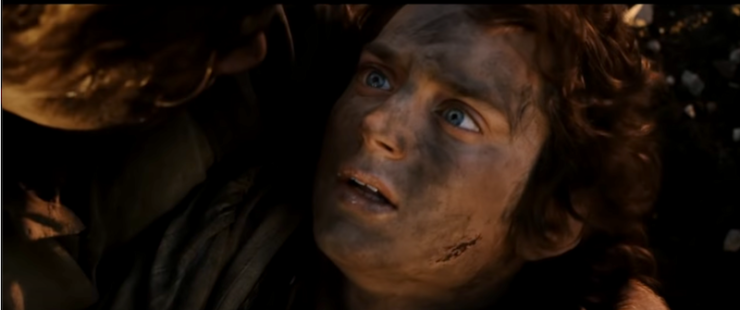
I used to have regular fights in high school with misguided souls who had watched the Lord of the Rings films, and somehow thought they were cool for insisting that Frodo should not have been the Ring-bearer. “He’s weak,” they’d say. “Aragorn could have taken the Ring.” This despite the fact that the narrative, on film and in print, goes out of its way to address the fact that, no, Aragorn can’t carry the Ring, no one can carry the Ring except Frodo (and briefly Sam) to its needed destination. That is literally The Point of the story. We should not need to have this conversation.
The films may not linger as much on this point, but my extreme sympathy for Frodo stemmed from the fact that he was constantly in pain in order to carry out his heroic task. Whether it was physical hurting or psychic hurting or devastating fatigue, the fact that Frodo makes it to Mount Doom is a testament to his his incredible strength of character (and Sam’s as well, of course). Even after doing his good deed, he still has to contend with the echoes of all that strain on his body—he loses a finger and has a magical stab wound that frequently acts up when he’s trying to go about his hobbit business. Point is, don’t you dare claim Frodo was second best. He is good and he is tired, and you should be nice to him.
Laura Roslin—Battlestar Galactica
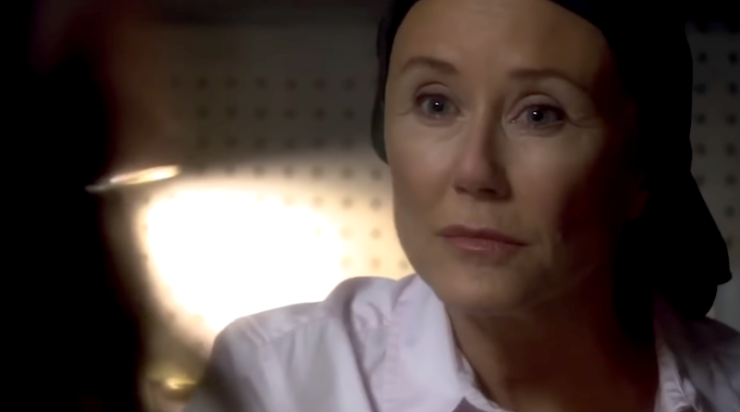
Bad enough being in charge of the fate of all humanity—being responsible for keeping humanity going after a genocidal event probably isn’t high on anyone’s list of dream jobs—Laura Roslin has to balance this job with constant stays in sick bay. She receives a breast cancer diagnosis right before the Cylon attack on the Twelve Colonies, precipitating her ascendancy to the Presidency. Following that, she has to manage her condition and the responsibilities of that job to the best of her ability. For a time, she appears to have beaten the cancer, but when it returns her condition is actually used against her in the trial of Gaius Baltar.
Laura Roslin spends practically her entire tenure as leader of humankind going back and forth between various treatments for her cancer, some of which are drugs with hallucinogenic side effects that give her very special visions of a prophetic sort. And to compound this already untenable lot, she falls in love with Admiral Adama, knowing that she is unlikely to survive and build a life with him on the other side of their journey. In the parlance of our times, your fave could never. Questionable choices aside, Laura Roslin has my unyielding affection and awe.
Spock—Star Trek

As a character, Spock deals with a lot of emotional pain due to difficulties reconciling his human and Vulcan heritages. He’s also one of Trek’s primary punching bags, injured often for the sake of making the audience feel bad. Then someone has to worry over him (usually Kirk, McCoy, or some combination of the two), and we all live vicariously. This precious pointy boy. It’s difficult having emotions and also getting flung to and fro by strange aliens with mind powers.
But perhaps the most relatable aspect of Spock’s damsel status is the fact that he’s always desperate to get back to his station and do his job, no matter how much everything hurts. We see it in several episodes, including “Operation: Annihilate!” where Spock is infected by an alien that fixes itself to his nervous system and keeps him in agony. At one point, McCoy tells Kirk that according to his instruments, Spock is in so much pain that he shouldn’t even be conscious, but Spock is still trying to drag himself to the bridge and do Starfleet stuff. Big mood, Spock. Big. Mood.
Wolverine—X-Men
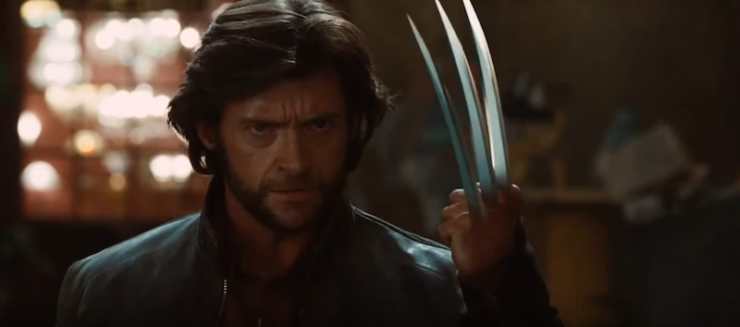
I never really cared much about Wolverine, even as a kid from the generation that grew up on X-Men: The Animated Series. He’s just kinda grumpy and funny and there to cause problems. Then the first X-Men film came out in 2000 and Hugh Jackman gruffly informed Anna Paquin that the claws hurt when they shoot out from his knuckles “every time” and my whole view of the character shifted. Why would you do that to me? He’s just there to smoke cigars and talk about Canada every once in a while. He’s supposed to pine after Jean because he has no life, and then vanish from sight.
But that scene permanently reframed Wolverine as a character whose mutant “powers” are also a source of constant pain. And then you have to think about it every time he extends those adamantium claws. There they are—ouch. And again—double ouch. Do they keep hurting while they’re out? Does the ache only cease when they retract into his arm bones? Does the repeat trauma of slicing through muscle and skin to emerge outside his body ever make him reluctant to use them? I feel like even with those fancy healing powers, I’d develop an extreme aversion to unleashing my slashy friends. Sheesh, Logan. Have another cheap whiskey on me.
Scorpius and Pilot—Farscape
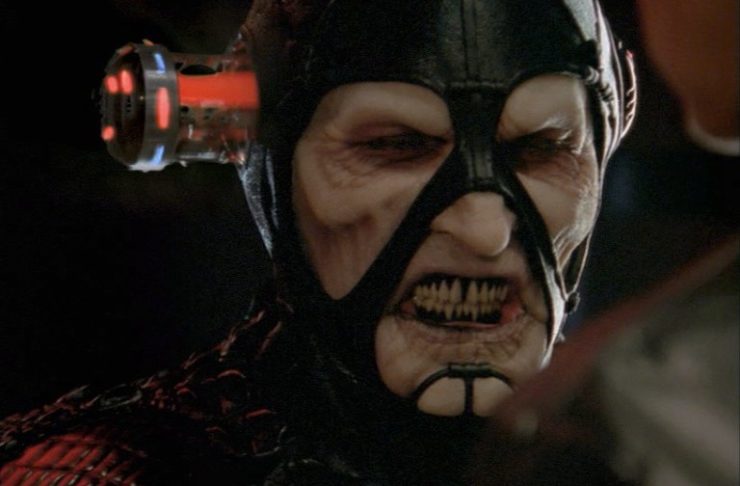
Let’s be honest, I could have picked anyone in Farscape for this list because most of the characters on this show deal with some form of pain or another. Pilot and Scorpius top my list for two very different reasons, though. In Pilot’s case, we go through an entire season of the show before we find out that Pilot’s bond to the Leviathan ship Moya was not allowed to occur naturally; he was grafted into her systems after Moya’s previous Pilot was murdered, which meant that Pilot was forced to endure constant pain as a result of his forced connection. The crew eventually rebond him to the ship so he can continue without pain, but he goes years without mentioning his discomfort to anyone out of guilt and shame.
Then there’s Scorpius, whose pain comes from the fact that he is the result of forced interspecies breeding between a Scarran and Sebacean. Since one of these species thrives on heat and the other slips into a coma when it gets too warm, Scorpius cannot regulate his own body temperature. This problem is used to torture him as a child, but he manages to create a system by which cooling rods can be inserted into his brain to maintain his internal temperature. Still, the system requires that he change these cooling rods frequently in order to survive. It’s not a pretty picture, but Scorpius keeps his composure regardless—he’s a beast when it comes to control under pressure, and I adore him for it.
Avatar Korra—The Legend of Korra

So many things come so easily to Korra when she’s young, but the universe seems intent on ridding her of the ease very quickly. First, she loses the ability to bend water, fire, and earth thanks to Amon, and requires the aid of Avatar Aang’s spirit to regain it. Then Korra is kidnapped by Red Lotus member Zaheer, and poisoned with mercury. She uses a wheelchair for a time, and though she eventually regains the ability to walk through vigorous physical therapy, she can no longer enter the Avatar State. Korra also suffers from PSTD following her confrontation with Zaheer, and has residual mercury in her body that cannot be removed due to her own subconscious pushback.
With the help of Toph Beifong, Korra eventually releases her fears and rids herself of the remaining poison, regaining all of her abilities. But her rehabilitation is arduous, frightening, and painful, which is rare to see in stories about big heroes who do great deeds. Anyone who has gone through rehab for physical, mental, or emotional trauma can find truth in Korra’s story, and for that, I’ll never hear a word against her.
John Silver—Black Sails
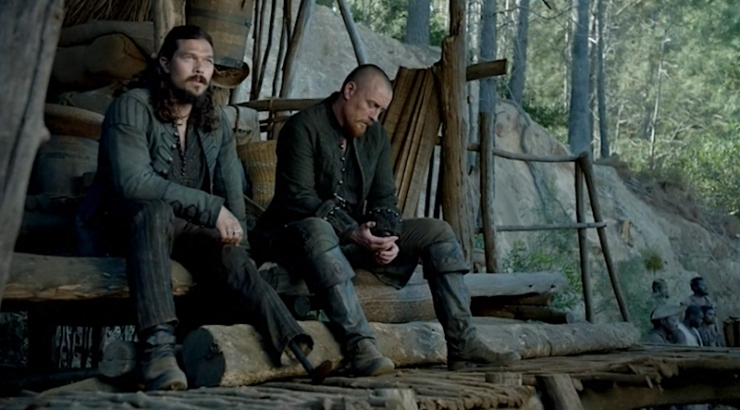
Look, it’s not exactly SFF, but it’s a prequel to Treasure Island, so I say it counts. The point is, John Silver doesn’t like Captain Flint’s crusade, he doesn’t like pirates or cooking or vendettas, he doesn’t even like the ocean. But he stays because the gold Flint has a mind to capture could give him true freedom. Then he ends up catching too many feelings for the people around him, which leads to a noble deed, which leads to having his leg bashed to pieces with a mallet and the amputation of said leg to save his life.
Keeping that leg from getting infected before the invention of penicillin is not an easy task, and Silver ends up trading out a painful and inflexible prosthetic for his more famous crutch. Thing is, if you’ve ever walked with a crutch, you know how quickly that can throw your spine out of alignment and lead to a torrent of back and hip issues. And John Silver is dealing with that on the decks of ships, where you’re tossed back and forth perpetually. The point being, there is no way he’s not in some amount of pain, consistently. And my brain will not allow me to ignore it.
Remus Lupin—The Harry Potter Series by J.K. Rowling
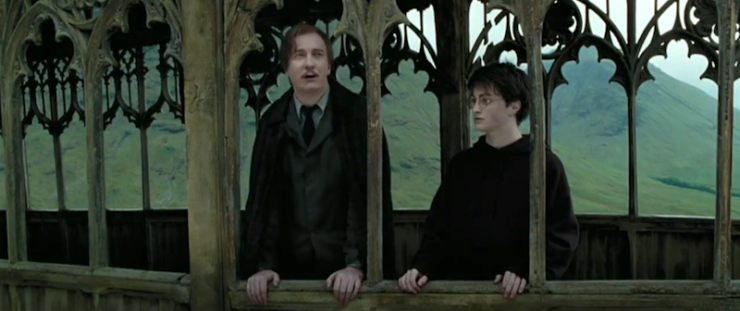
J.K. Rowling went out of her way to say that Remus Lupin’s lycanthropy was a metaphor for AIDS and diseases like it, which is a weird thing to insist in regard to your book series where not a single character ever mentions being queer on the page. But that’s neither here nor there. Author commentary notwithstanding, Lupin’s little werewolf problem is an easy analog for any number of chronic illnesses—especially ones that come with “flares” that reassert the disease or condition over and over.
I happen to have one of those, and was reading Harry Potter at a point in life when my condition was rearing its head. Lupin’s monthly rewounding, as his body broke into a werewolf shape and then rebroke back into a human one… it burrowed into my brain like a small, soft rodent in need of a home and never let me go. He will always be my favorite character in the series, and that is greatest measure of why: Remus Lupin, shunned and deemed unemployable and always in some form of pain or another, yet it never stopped him from being kind. From educating others. From trying to give as much as he could when he had virtually nothing. Just give him a cottage near a sleepy town with a decent chocolate shop and leave him be.
This is honestly just a preliminary head count from the League of Pain Friends that I have lurking about in my brain. Who are yours?
Emmet Asher-Perrin needs a League of Pain Friends patch for a denim jacket. You can bug him on Twitter, and read more of her work here and elsewhere.










